|
|
Ski
Bowl Inc.
Saxtons River, VT 1936-1941 (May have briefly operated after World War II) |
History ~ Historic Photos ~ Christmas Cards ~ Articles ~ Today ~ Listings ~ Memories
|
|
Ski
Bowl Inc.
Saxtons River, VT 1936-1941 (May have briefly operated after World War II) |
History ~ Historic Photos ~ Christmas Cards ~ Articles ~ Today ~ Listings ~ Memories
| The Bellow Falls Ski Bowl
was started by Robert Hogarth, back in 1936. The area was
constructed that year, and opened in 1937. The area lasted until the
family moved away in 1941. The trails were laid out by the famous
Charles Proctor. Proctor laid out several trails around New England,
including the Sherburne trail at Mt. Washington, and helped run a ski
school at Mailbox
Hill in NH. The area was fairly unique and well developed for such an early area. It had a more modern brochure with pictures, a trail map, directions, etc. The setup was also quite unique - skiers would park at a lot on Ski Bowl Road just off of Rte 121. There, they would ride a shuttle bus to the ski area up a fairly difficult road. There, a 1000' tow served several narrow woods trails, a few wide open slopes, and an instruction area. The trails had an average grade of 12 degrees, with the slopes ranging from 10 to 30 degrees. From the top of the tow to the bottom of the lift was a 240' drop. A 400' drop was possible to the parking lot. A lodge served up delicious food and hot chocolate. Lessons were taught by Jack Durrance, brother of the famous racer Dick Durrance. Several of our readers informed NELSAP that as youngsters, they had little money for lessons - and would follow behind Jack's lessons to learn how to ski. Jack was good natured and enjoyed the kids who wanted to learn how to ski. To the right is a historic trail map from the late 1930's or early 40's. Unfortunately, its a large map and couldn't be scanned, so I took a photo of it. I will try to get a better image in the future. Please click on it to see the larger version with much more detail. On a side note - the detail is quite amazing - don't you wish all modern trail maps could be like this?
|
|
|
Unfortunately, the
area closed in 1941, as the family moved away. The area reverted
back to woods and fields. Betsy McDonough and I tried to find it in
2000 - no luck with the area, but the Ski Bowl Road is still
inhabited and easy to drive. Here's more from the son's founder, Dick Hogarth: My name is Dick Hogarth. My dad built Ski Bowl in the original spot in Saxons River. He started it in 1936, It operated 1937to when we moved in 1941. I have lots of pictures of the trails ,warming house where my mom served coffee etc, Jack Durrance was our instructor. Lots of busses came up from NYC. We have volumes of info, clippings, pictures etc. Went back there in 1991, and it was all grown up with new trees, but with our photos, my brother and I could make out the trails with there lighter green leaves. Lots of memories of my boyhood there, and our parents hard work in creating it..
|
Dad had developed Ski Bowl, NOT as a ski enthusiast, but as a means to earn income year round, especially when crops could not be raised, or gardens grown to provide food for our family of 6.
And from another son, Robert Jr.: I am Bob Hogarth, Jr. My Dad started Ski Bowl, and ran it for a few years. After the hurricane of '38, I helped him clear the fallen trees, in order to get ready for the season.
Note - Ellen Golec's tells us her father operated the area for a few years after WWII. His name was Edward Howard Jr. This will continue to be researched...
|
Bill Jenkins, who helped found and
operate several ski areas in Vermont, learned to ski here. He
sent us a rare brochure which helps illustrate the area nicely -
all historical pictures on this page area from him. You can view
the inside of the brochure by clicking on it on the right side
of this table. Below is his detailed memories: |
|
|
I learned my skiing in the late thirties and
early forties, on this superb little mountain. Actually, the slopes were the
high meadows of a farm. To reach the area, skiers parked their cars at the
bottom of a very long and steep road. There you got on a school bus equipped
with chains. Cars of those days never would have made it up. On reaching the top, you could ski down to the bottom of the Bowl. There, a rather nice rustic hut was located. Great food was served, and it was really warm and comfortable. The slopes were really exciting, and of all skill levels. The tow was fast, so you could get in a lot of skiing. Crowds were in the hundreds when the skiing was good, and the sun came out. It didn't require a lot of snow was the pastures were grazed smooth by the cattle. There was also a ski jump off to the right of the slopes.
|
| Jack Durrance of Dartmouth College, and a brother
of the famous racer Dick Durrance, gave ski lessons there. As most of the kids
had no money for lessons, we would stand as near as possible to hear his
instruction, then we would sneak off to another part of the slopes to practice
what he had been saying. Jack was well aware of our little and obvious subterfuges, and got quite a bit enjoyment as he knew we really wanted to learn. He never discouraged our kibitzing, and was a great and friendly role model. When the ski day was over, we all hiked back up the top of the Bowl to load on the bus and go down the hill, or skied down to the parking lot if there was sufficient snow. I believe it closed during World War II. It seems a bit unthinkable as I think back on it, but scores of us often walked and skied the two and half miles from Bellows Falls, to take the bus up the hill. This meant we carried our skis, if there wasn't enough snow on the snowbanks to ski on the edges. And at the end of the ski day, we walked or skied back to Bellows Falls! A side note - during this period, our sidewalks were plowed by wooden V plows, pulled by a team of draft horses. If the snow got too deep for the snowplow trucks, they hitched up 4 to 8 horses and rolled the roads with a wooden roller 8ft wide with a diameter of 6 or 8ft. With no salt used, snowbanks along the streets were so high that you couldn't see the road from the sidewalk. We didn't have front end loaders in those days to haul the snow away. To the right is a map of New England showing the location of the ski area and distances to it. |
|
Dick Hogarth sent NELSAP some terrific photos of the area, all of which are below, and show various elements of the Ski Bowl.
Slopes, Tows, and Skiers
| Here, Bill and Dick Hogarth (bottom left) as youngsters on the slope. Click for larger. |
| View of most of the liftline and lodge, along with the open slope. Click for larger. |
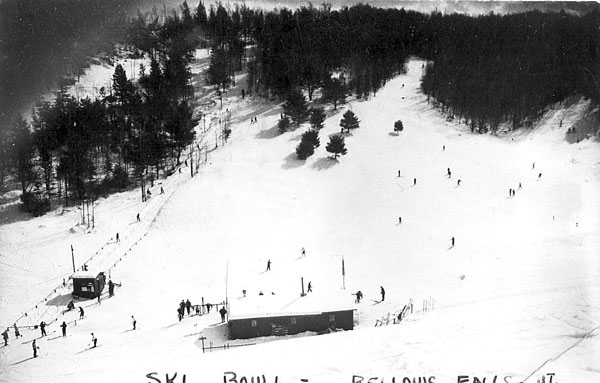 |
| A view of the wide open slopes surrounding the base lodge. Click for larger. |
| The bottom of the slope, and lodge. Click for larger. |
| Starting up on the rope tow. Click for larger. |
| A skier comes down through the woods. Click for larger. |
| A lady poses for a photo on the slope. |
Lodge/Farmhouse
| The farmhouse at the ski area. |
|
|
|
A view of the base lodge. |
| Skiers at the lodge. It's hard to see, but you can see some skiers at a slope behind it. Click for larger. |
| Groups of ladies inside the lodge. Click for larger. |
Parking
| Skiers arrive at the area. It is likely that this is the bus that picked up skiers from the parking lot and brought them to the lodge. Click for larger. |
| Lines of cars parked at the ski area. Click for larger. |
Several Christmas cards were issued during the late 1930's/early 1940's. These were provided to NELSAP by Dick Hogarth. Click on each image for the larger version.
The Ski Bowl, sometimes referenced as "Bellows Falls", was mentioned in quite a few articles and ski reports during the late 1930's/early 1940's. Dick Hogarth has provided us with a lot of these newspaper articles. Please click on each one for the larger version.
 |
 |
 |
 |
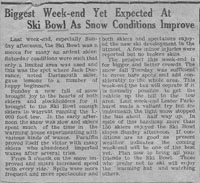 |
 |
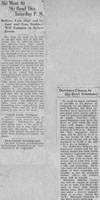 |
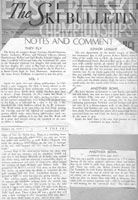 |
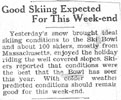 |
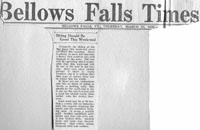 |
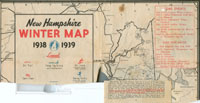 |
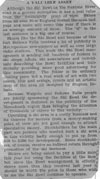 |
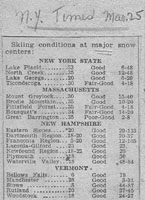 |
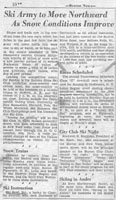 |
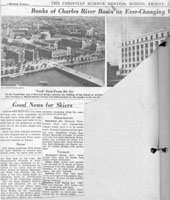 |
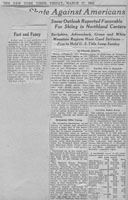 |
| We don't have any images of the area today, except for this overheard view from Terraserver. I marked to possible location of the area, but this is just a guess. |
|
| Year | Lifts | Trails | Other Info | Source |
| 1939 | 1000' tow | 4 trails, north exposure. Open slopes. | 3 miles NW of town on VT 121 | Ski Guide to New England |
| 1942 | 1100' tow | 4 "sporty" trails, open slopes for novices through experts | 3 miles out of town | Complete Skier's Guide |
Norman MacLeod: "The Ski Bowl was indeed about three miles out of Bellows Falls, Vermont. It was actually about a mile up a hill to the west of Route 121. I grew up between that secondary road and the Hall Bridge, and the area was gone before I ever arrived on the scene in the early 50s."
Betty Ripley: In February 1939, my first date with my husband of 66 years (so far) was skiing at the Ski Bowl in Bellows Falls, VT. There was no lift, that I know of. There was a bus from the bottom to the top of the trail. It returned to the base to pick up the skiers and took them back you to the top. The trip down was like a trail rather than an open slope, winding around as if a road. I was not much of a skier then, but it was just right for me.
Roland Sabourin: Let me tell you about the first years of the Ski Bowl. It was a gorgeous ski area built in a natural bowl. I started skiing there in '39 and quit in the winter of '41-'42 to go into the service. You had to park in the lot off the road to Saxton's River, take a bus to the farmhouse at the top of the bowl, then ski or walk down to the warming hut. The rope tow was just in front of the hut. The area used to draw people from MA and all around the Vermont area. Vividly remember the spring skiing days when that rope tow was a bear to hold onto. Recall that Jack Durrance was a ski instructor there, I believe in '39. Us young guys used to hide in the woods between trails and listen to his instructions. For myself, the area was a start of 60 years of skiing.
If you remember this area, please email us with your story.
Last updated: December 26, 2008